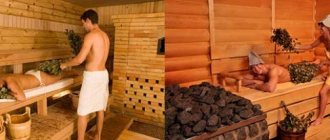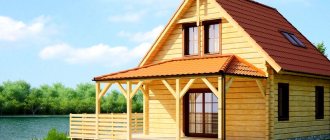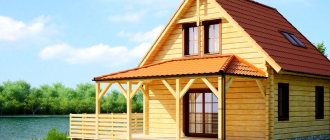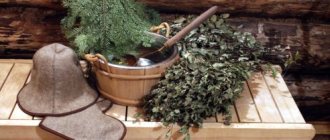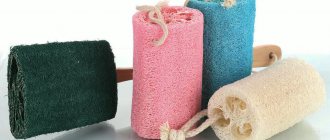Nettle is difficult to confuse with any other plant. Most of us avoid it; no one wants to get stung. And in the bathing kingdom, nettle faithfully serves us; here its stinging hairs are not at all scary. Quite the contrary, steaming with a nettle broom is very useful!
I will begin my story from ancient times, when diseases and ailments were treated with infusions and decoctions of plants, herbs and flowers...
I think in ancient times they did not know about the presence of vitamins and nutrients in nettles. The burning effect of the plant was used for medicinal purposes; nettles were used to lash the body to warm up and relieve pain.
Nettle was used to treat wounds and stop bleeding; it was a talisman, protection from evil spirits. By the way, in the old days, nettle brooms were very popular in the bathhouse.
Is it possible to steam with a nettle broom in a bathhouse, is it useful to whip with it?
When dried and scalded, the herb loses its ability to burn the skin to the point of blistering. You can steam it without fear, but you most likely won’t be able to whip it. When steamed, the leaves and stems of the plant soften. A “clean” nettle broom is of little use for a bath; you will have to use it more like a washcloth. But if you add a few tree branches to the bunch, the situation will change. This improved nettle broom can already be used for a Russian bath. Tree branches will give it rigidity.
You can whip with such a prefabricated broom in the same way as with an ordinary branch broom. But its “service life” will be a little shorter due to the fact that the soft nettle stems will quickly become unusable. Because of this, you shouldn’t expect much benefit from a nettle broom for a bath, but it won’t do any harm either. At best, you will get an analogue of a compress with a herbal decoction, at worst – a placebo effect.
We recommend reading: Tea with thyme: beneficial properties and contraindications
Dry nettle will definitely not do any harm
Types of nettles
There are several varieties of the plant in question:
- Burning. An annual plant with a stem height of ½ meter. It got its name because of the severe pain it causes to people and animals who touch its small leaves with many small needles along the edges.
- Dioecious is a perennial variety reaching a height of two meters. The tetrahedral stem bears large leaves with needles. Best used for pain in the lumbar region.
- Hemp. An elegant herbaceous perennial with large, deeply palmate leaves.
- Deaf. This species does not have needles and does not have healing properties, so it makes no sense to prepare brooms from such nettles for a bath.
Making your own bath broom from nettle is quite simple, because the raw material for making it grows everywhere and is considered a weed.
What are the benefits of a nettle broom for a bath?
The opinion about the beneficial properties of nettle brooms for a bath is based on the rich chemical composition of the herb. Although from this point of view it is better to drink decoctions. Dried and then steamed nettle bunch is actually ineffective. Protective needles lose their ability to pierce the skin during the drying process. After steaming, the nettle leaves become limp, leaving only the stems as the relatively hard part.
But the grass is good for children with still thin skin. Tree rods can damage it, but nettle stems cannot.
Much more benefits come from fresh nettle stems. When steamed, the herb loses its pungency, but there are more active elements in it than in the dry plant.
The maximum effect is obtained from treatment with a broom of fresh nettle. But this is for extreme sports enthusiasts, since freshly picked grass strongly burns steamed skin.
In the steam room, nettle is used for certain types of diseases:
- rheumatism;
- arthritis;
- gout;
- diseases of the upper pulmonary tract;
- ORZ.
When there is a metabolic disorder in the bones, scalding nettle juice does not heal as much as it distracts the brain from the source of the lesion with additional pain. Lung and colds are treated by warming up in a steam room. This is especially true for viral “colds”, the causative agent of which dies if the body temperature exceeds 40 °C. Achieving such indications naturally can lead to CV complications. A short-term increase in body temperature in the steam room is less harmful, but also effectively kills viruses.
Comment! Nettle does not help with diseases such as tuberculosis, anemia or alopecia, even if you steam it in a bathhouse.
Freshly picked nettle stems are best for treating rheumatism.
Varieties of nettles
Nettle has many varieties, but the most common are stinging nettle and stinging nettle. Stinging nettle is an annual plant up to half a meter high, with thin stems and small, finely toothed leaves. Even with a light touch, blisters instantly appear on the skin and severe itching occurs. The medicinal properties of such nettle are very high, but it is not suitable for making a bath broom.
Stinging nettle is a perennial; it grows up to 1.5 meters tall, and sometimes up to 2 meters. Its stem is strong, tetrahedral, the leaves are quite large and covered with stinging hairs. Its healing qualities are no less high, and it does not burn as much, which is why bath brooms are knitted from stinging nettle.
Stinging nettle
stinging nettle
There are plants that look very similar to nettles, but do not have stinging hairs. They are popularly called dead nettles, but do not have any medicinal properties. It is very easy to confuse them with real nettles, and therefore before collecting plants you should check them for stinging properties.
White nettle (Deaf nettle)
Dead nettle (white nettle)
When to collect nettles and prepare brooms for a bath
Nettle brooms for a bath are made in that short period of time when the plant has already gained full growth, but has not yet formed buds. The condition is almost impossible, since the weeds tend to bloom as early as possible. Preparation of nettle brooms for a bath can be carried out during flowering and fruiting, but when dried, these small particles will begin to crumble. There will be a lot of garbage that attracts insects.
In the bath, flowers and seeds will stick to the body. Most of them will be washed away with water when rinsing, but some will remain and irritate the skin.
Sufficiently tall, fully formed stems are selected for use in the bath. They are cut off almost to the root. Whether to wear gloves for this purpose or receive a portion of medicinal juice during the preparation process, everyone decides for himself. The cut plants are laid out in a thin layer in the shade in the open air.
How to properly harvest nettles for brooms
You need to cut nettles for brooms until they bloom. Plants choose those that grow in the shade.
Nettle has several varieties: stinging nettle, stinging nettle and stinging nettle. All these types have varying degrees of pungency. While dead nettle hardly stings, stinging nettle burns more than stinging nettle.
The nettle harvest season lasts from May to July.
How to prepare and make a nettle broom for a bath
Further actions depend on immediate plans. If you need to make a bath broom from fresh nettles, some of the stems can be tied immediately after harvesting.
The lower parts of the stems, 15-20 cm long, are cleared of leaves and tied. A fresh nettle broom is ready for use in the bath. But you can’t store it, so you’ll have to steam on the same day. If harvesting is done for the winter, then the grass must be completely dried in the shade and only then formed into bunches. Next, the grass is hung in a ventilated area.
Attention! Under-dried nettles will rot in the middle of the bunch.
You need to avoid some mistakes when preparing:
- wrong collection location: you cannot collect grass near roads and railways, as well as in other contaminated areas;
- selection of old stems that have already begun to wither;
- sun drying;
- using a dry broom in a steam room without preparatory steps to restore its elasticity.
Except for the last one, all other rules apply to collecting any herb.
Plants hung to dry should not be kept in large bunches or close to the wall.
We prepare and make a nettle broom
Nettle is a well-known weed. However, since ancient times, from the very early spring, people have been plucking young shoots of the plant for green cabbage soup and salads, and in folk medicine, nettle is justifiably used as a multi-purpose medicinal plant.
In turn, nettle brooms, when applied to a Russian steam bath, are an excellent healing agent. And in terms of healing properties, nettle broom is confidently among the leaders of “bath health”. With such a broom you can simultaneously get pleasure and improve your health.
First of all, before you go steaming with such a broom, you need to make it after you have collected the nettles for it. Of course, today you can buy it, but try to assemble it yourself, because there is nothing complicated about it - in fact, it takes a few minutes.
It is possible and necessary to start harvesting nettle brooms earlier than the time when birch brooms are harvested, during the flowering period of the plant from late May, early June to July, when it contains the maximum amount of useful substances, since after flowering there are significantly fewer of them.
The best time to collect for subsequent long-term storage: late May - early June. Flowering plants should not be harvested. When preparing, protect your hands with mittens - tops or thick rubber gloves. Collection sites are chosen away from busy roads, highways and other places of possible pollution.
How to properly steam a nettle broom for a bath
Traditional twig brooms must be soaked before the steam room so that they become sufficiently soft and flexible. The grass is too tender for such a procedure. There is no need to even steam a fresh nettle broom. It is enough to dip it in hot water, take it out, shake it off and let it “breathe” with steam.
For dry nettle broom, the rules are slightly different, since its stems and leaves are fragile. First you need to soften them and achieve elasticity. There is also no need to brew dry nettle broom in boiling water.
A dried nettle broom must be prepared for the steam room according to certain rules:
- take two buckets of water, cold and hot, but not more than 75 ° C;
- place the broom in hot water and keep it there for five minutes;
- remove and place in a bucket of cold water for the same time;
- repeat the procedure until the nettle stems become elastic.
Next, a nettle broom is used in the same way as a “traditional” one made from tree branches.
Comment! After the steam room, you can brew a nettle broom with boiling water and make a foot bath.
Who shouldn't use a nettle broom?
In addition to its positive properties, nettle has several others that can significantly impair your health.
- If you have vein problems, do not use a broom made from this plant. The fact is that nettle thickens the blood, which negatively affects the clinical picture of the disease.
- Hypertensive patients should also not go to the steam room with nettles. Plant substances dilate blood vessels, which increases blood pressure. To avoid a hypertensive crisis, do not risk your own health by using nettle.
If you are shown nettle and other types of brooms, please contact our company. We will select the optimal means for going to the bathhouse that will benefit your health.
How to properly steam with a nettle broom in a bathhouse
It is not enough to properly prepare a nettle broom for a bath. When using herbs, you need to follow other rules to get the maximum effect from the steam room. Especially if fresh nettle is supposed to be used in the bath.
To avoid “traditional” nettle burns, the body also needs to be prepared:
- on the first visit, warm up on the shelf;
- come out to cool for 2-3 minutes;
- You can start steaming the second time, when the body becomes hot and the skin is elastic;
- Before leaving, douse yourself with warm water.
The skin after a steam room always turns red from the rush of blood. Nettle makes this color more saturated. There is no need to be afraid. In an hour everything will be over.
Comment! If you soak a used nettle broom in warm water in a basin, you can make a foot bath.
Which nettle is suitable for a bath broom?
If you unknowingly collect nettles that are not suitable for use in a steam room, you risk adding a lot of health problems to your existing ones. Therefore, we will consider in detail the characteristics of each type of nettle.
- In nature there is an annual stinging nettle. A nettle broom for a bath, the benefits of which are invaluable, in this case will not work from this plant. This herb is an annual and leaves blisters when it comes into contact with the skin. Therefore, using it in a steam room is strictly prohibited.
- Nettle broom, the benefits of which will be visible after the first use, will be excellent from stinging nettle. This is a perennial plant, which, compared to its previous brother, does not leave blisters. At the same time, it is necessary to collect it, observing all safety rules - wearing gloves, avoiding contact with skin.
These are the types of plants found in nature. The main thing is to choose the “right” one in order to get the maximum effect from use.
How to properly store nettle brooms
After drying, the nettle brooms stored for the winter still need to be preserved. The herb is usually placed in paper or linen bags and placed in a dark place.
But you have to handle the broom differently. It is also protected from direct sunlight. The easiest way to do this is to hang the bunches from the ceiling in a well-ventilated area.
Important point! The brooms should not touch each other. Too close placement interferes with air circulation, but creates a good shelter for insects.
There should be no sources of water in the storage facility, including full buckets. The large amount of nutrients in nettles provokes the rapid development of mold on it. If the air humidity is too high.
Since dry grass easily ignites, there should be no flammable devices or source of open flame in the room. You cannot “dry” the air using a gas gun or a heater with an open spiral. Let's just say an oil heater. But you can’t put nettles on it or hang brooms directly above it either.
Placing nettle bunches too tightly leads to mold due to lack of air circulation
The benefits and harms of nettle brooms
Benefits of nettle broom:
- cures diseases of the upper respiratory tract;
- relieves diseases of gout and rheumatism;
- improves skin condition;
- treats colds;
- is a preventative against baldness.
Contraindications:
- with kidney disease;
- in the presence of hypertension and other diseases of the cardiovascular system;
- in the presence of open wounds and ulcers;
- for oncological diseases.
The advantage of nettle brooms is the presence of a large amount of useful substances in them and the availability of the plant. The disadvantages include the rapid wear of the nettle broom, which causes the leaves of the plant to fall off. Nettle brooms collected in dry weather are hung to dry in a well-ventilated area.
Contraindications
Contraindications related to the use of nettle brooms in the bath are the same as for any others. The prohibitions apply directly to the steam room. Not every person benefits from a Russian bath.
You should not take a steam bath if you have the following diseases:
- hypertension;
- CVD diseases;
- kidney diseases;
- pregnancy, especially the first trimester, as there is a high probability of miscarriage;
- open wounds;
- furunculosis;
- varicose veins;
- tendency to thrombosis;
- obesity;
- epilepsy;
- various mental disorders;
- cancerous tumors;
- high body temperature with any disease.
Visiting the steam room with these diseases is undesirable even without the use of bath brooms.
How to make a nettle washcloth with your own hands
A good alternative to a nettle broom for a bath can be a washcloth made from this plant. The raw materials for it are collected after the end of the long rains in September. After such intense saturation with moisture, the nettle skin is easily separated, then it is dried and rolled into a convenient sponge-twig.
Use only juicy, well-moistened grass for sponging
Contraindications to the use of nettle
Any plant has both its beneficial qualities and contraindications for use. Thus, nettle is prohibited for use in
case of individual intolerance and a number of others:
- if the woman is in the first trimester of pregnancy;
- if a person is undergoing treatment using antidepressants, drugs for insomnia;
- the presence of thrombophlebitis, varicose veins, atherosclerosis;
- Humans are characterized by increased blood clotting;
- the person has hypertension;
- bleeding is observed as a result of cysts, irrigation, and other uterine tumors;
- presence of severe kidney disease.
How does a bath act on blood vessels?
The air temperature in the steam room of a classic Russian bath rises to 60-70°C, and humidity - up to 90%. These values are close to natural conditions and are well tolerated by a healthy body. Hot, humid air starts the process of redistributing blood supply to the arms and legs. The vessels dilate, the volume of circulating blood increases, and accordingly, the load on the veins and arteries increases. For healthy vessels, such a load does not pose a problem, but veins affected by varicose veins “delegate” it to the deep venous trunks. Frequent visits to the bathhouse with varicose veins provoke damage not only to the superficial, but also to the deep veins: their walls thicken and lose elasticity.




